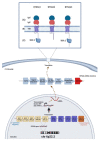BTN3A: A Promising Immune Checkpoint for Cancer Prognosis and Treatment
- PMID: 36362212
- PMCID: PMC9653866
- DOI: 10.3390/ijms232113424
BTN3A: A Promising Immune Checkpoint for Cancer Prognosis and Treatment
Abstract
Butyrophilin-3A (BTN3A) subfamily members are a group of immunoglobulins present on the surface of different cell types, including innate and cancer cells. Due to their high similarity with the B7 family members, different studies have been conducted and revealed the involvement of BTN3A molecules in modulating T cell activity within the tumor microenvironment (TME). However, a great part of this research focused on γδ T cells and how BTN3A contributes to their functions. In this review, we will depict the roles and various aspects of BTN3A molecules in distinct tumor microenvironments and review how BTN3A receptors modulate diverse immune effector functions including those of CD4+ (Th1), cytotoxic CD8+ T cells, and NK cells. We will also highlight the potential of BTN3A molecules as therapeutic targets for effective immunotherapy and successful cancer control, which could represent a bright future for patient treatment.
Keywords: BTN3A; T lymphocytes; cancer; immune system; prognostic factor.
Conflict of interest statement
The authors declare no conflict of interest.
Figures


References
Publication types
MeSH terms
Substances
Grants and funding
LinkOut - more resources
Full Text Sources
Other Literature Sources
Medical
Research Materials

